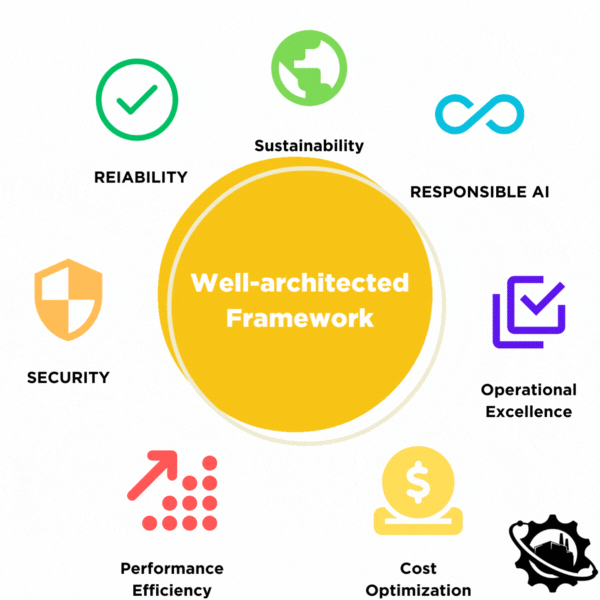Well-architected Intelligent Apps

When evaluating Intelligent Apps, it's common to conduct a proof of concept (PoC), which can be completed relatively quickly. This often leads to a misconception that Intelligent Apps are easy to build and can be made production-ready in just a few days. However, this is far from the truth. To prepare intelligent applications for production, several factors need to be considered. These considerations are modeled around the Well-Architected Frameworks provided by major cloud providers1 2 3.
Pillars of the Well-Architected Framework for Intelligent Applications:
-
Security
Robust measures to protect information, systems, and assets, delivering business value through risk assessments and mitigation strategies.
-
Responsible AI
Guardrails, practices, & principles to keep your use of AI ethical and trusted by your organization and users.
-
Reliability
Assurances in application code, infrastructure, and operations. Including at the Evaluation & testing, both at the application, model, and data level.
-
Operational Excellence
Applying DevOps practices to achieve workload quality, process efficiency, and customer satisfaction.
-
Performance Efficiency
How well your intelligent app adapts to varying demands and optimizes its resources and capacity.
-
Cost Optimization
Aligning business goals, ROI, and financial constraints with a cost-optimized strategy.
-
Sustainability
Environmental impacts, especially energy consumption and efficiency to reduce resource usage.
Organizations can make this easier on development teams of Intelligent Apps by investing to platform engineering techniques that can lead a Internal Developer Platform (IDP) to produce better Intelligent Apps, faster.
What is the Well-Architected Framework?
The Well-Architected Framework is a set of guiding tenets that can be used to improve the quality of a system. It provides a consistent approach for customers and partners to evaluate architectures, and provides guidance to help implement designs that will scale with application needs over time. The framework is based on five or six pillars — operational excellence, security, reliability, performance efficiency, cost optimization, and sustainability (depending on the hyper-scaler). It provides a set of questions that allows you to understand if a specific architecture aligns well with cloud best practices.
We have added the additional pillar of Responsible AI, which is a set of guardrails, practices, and principles to keep your use of AI ethical and trusted by your organization and users.
Applying the Well-Architected Framework to Intelligent Apps
The Well-Architected Framework is not only applicable to traditional applications but also to Intelligent Apps. The addition of the Responsible AI pillar further enhances its relevance to Intelligent Apps. Here's how each pillar applies:
-
Security: Ensuring the privacy and protection of data is paramount in Intelligent Apps. This includes data used for training AI models and the data generated by these models.
-
Responsible AI: This new pillar is particularly relevant to Intelligent Apps. It involves ensuring that AI models are transparent, fair, reliable, and safe. It also includes considerations for the ethical implications of AI.
-
Reliability: Intelligent Apps must be reliable in their performance and predictions. This involves robust testing and validation of AI models.
-
Performance Efficiency: Intelligent Apps should be designed to efficiently use resources and adapt to changes in demand. This includes the efficient use of computational resources for training and inference.
-
Cost Optimization: Like any application, Intelligent Apps should be cost-effective. This involves optimizing the costs associated with data storage, computation, and other resources.
-
Operational Excellence: Applying DevOps practices to AI development processes can help ensure the quality and efficiency of Intelligent Apps.
-
Sustainability: Intelligent Apps should be designed with consideration for their environmental impact. This includes the energy used for training and running AI models.
By considering these pillars during the development of Intelligent Apps, organizations can ensure they are building high-quality, ethical, and efficient applications.
Well-architected Review
A Well-Architected Review is a systematic approach to evaluating systems based on the principles of the Well-Architected Framework. It involves assessing an application or system against the pillars of the framework, identifying areas for improvement, and implementing remediation plans to enhance the system's quality, performance, and reliability.
Here are the link to the Well-Architected Frameworks for Azure: Azure Well-Architected Review.
Tradeoff between the Pillars
The Well-Architected Framework is designed to help organizations make informed decisions about their architectures. However, it's important to recognize that there are trade-offs between the pillars. For example, optimizing for cost may involve trade-offs with reliability or performance efficiency. Similarly, optimizing for security may involve trade-offs with cost or operational excellence.
By understanding these trade-offs, organizations can make informed decisions about how to balance the pillars based on their specific requirements and constraints. This can help them build Intelligent Apps that are well-architected and aligned with their business goals.
Conclusion
The Well-Architected Framework provides a valuable set of guiding tenets for building high-quality applications. By applying these principles to Intelligent Apps, organizations can ensure that they are building reliable, secure, scalable, cost-effective, and ethical AI applications. This can help them deliver value to customers and stakeholders while minimizing risk and ensuring compliance with best practices and principles.